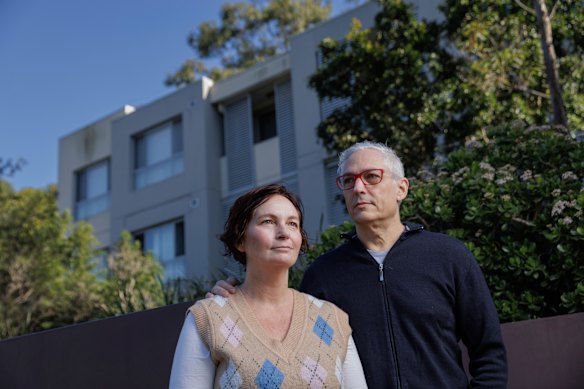- Exclusive
- Politics
- Federal
- Renewables
Home batteries for renters? A solution could be coming soon
By Mike Foley and Nick Toscano
More than 4 million people who live in rented accommodation have been missing out on the renewable revolution – until now.
Some of the country’s biggest electricity companies have signalled plans for free household batteries that could slash power bills.

“Any support … would be very gratefully received”: Eastwood apartment owners Caroline and Graeme Edwards. Credit: Max Mason-Hubers
Federal government rebates that wipe 30 per cent off the cost of buying and installing home batteries have been wildly popular since they started in July, driving a 400 per cent spike in sales.
But there is little incentive for renters to spend $10,000 or more to install a battery, coupled with solar panels, on a home they do not own, or for landlords to pay for the device to subsidise power bills they do not pay.
Debate over the equity of battery rebates is sharpening as the Albanese government prepares for parliament to reconvene on Tuesday, for the first time since the election in May. The government will start with new legislation to stop the industrial umpire changing rules to remove penalty rates in exchange for higher base pay for workers.
“One area that we have been thinking a lot about is how can we make sure customers who don’t own their own home, or who can’t afford to buy a solar or battery, can still participate through the [renewable] transition,” said AGL chief customer officer Jo Egan.
“We are looking at models where we can own the hardware with our capital, on a customer’s home or premises, and they can still access the benefits.”
Such models would create a so-called “virtual” power plant, with batteries bought and installed by AGL. Known as a VPP, the system is a network of hundreds or thousands of interconnected homes with rooftop solar panels and batteries.
This network of homes gives the energy provider access to a significant volume of electricity generated by solar panels as well as that stored in batteries.
Energy companies, aided by advanced software, can use these networks as a single “virtual” power plant to send bursts of electricity into the grid when needed, such as afternoon peak energy usage periods, when people return from work, when coal plants are faltering due to technical issues or when cloudy and windy weather is cutting output from large-scale solar and wind farms.
A household battery delivers savings by charging on free solar power from rooftop panels during the day and discharging at night to power the house when demand on the electricity grid rises, driving up prices. An appropriate-sized battery could significantly cut or even remove the electricity bill of a typical household in Melbourne and Sydney, which pays $1500 to $2000 a year for electricity.
Origin Energy general manager of retail Jon Briskin said an “enormous amount” of home battery storage coming online could be looped into a VPP.
“We see it as a core part of a cleaner and cheaper energy system … and it should lower customers’ energy costs,” Briskin said.
Why would energy providers want to use this system? For the simple reason that it could be cheaper than the alternative: either building gas plants or large-scale batteries to power thousands of homes at once.
Former renter Caroline Edwards and her partner, Graeme, wanted to install solar panels and a battery at their house to cut their bills and contribute to lowering emissions from the electricity grid, but they were reluctant to speak to their landlord about getting solar panels and batteries.
“We would also have been happy to contribute something to that investment. We had a great landlord, but we were hesitant to ask him because there was no immediate financial return for him,” said Caroline, who moved into her own property in November.
“We were also hesitant because if we were to put forward a proposal for our investment as part of that, we have no rental security.”
They are also landlords of a rented property, and Caroline said it should be imperative for governments to encourage renters and landlords to invest in solar and batteries.
“Literally, any support that we can get to make this an easier process for us to move forward with would be very gratefully received.”
Federal Energy Minister Chris Bowen said the government was already helping renters and low-income households access cheaper clean energy through the government’s $100 million Solar Banks program for rooftop solar to power rented apartments, as well as investing in energy-efficient upgrades to social housing, with insulation upgrades, home batteries and efficient appliances.
Solar Citizens campaigner Charlie Rodrick said renters had been too long locked out of the clean energy transition.
“The issue of split incentive between landlords and their tenants has meant that solar and battery uptake has been low across the board,” she said, “despite the rebates that are available.”
Cut through the noise of federal politics with news, views and expert analysis from Jacqueline Maley. Subscribers can sign up to our weekly Inside Politics newsletter here.